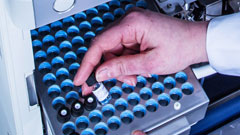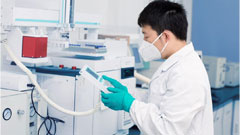GC
In gas chromatography, sample preparation is critical to obtain the right result. Choosing the right chemicals for your method and application will help you for a succesful analysis. VWR offers a broad range of chemicals for sample preparation of gas chromatography, such as solvents for headspace, pesticide and organic substances trace analysis, MOSH/MOAH applications, etc.
Product Categories

Solvents for special GC applications
High purity solvents designed for use in gas chromatography coupled with mass spectrometric detection or for some special analysis, offering a clear baseline and a minimal signal-to-noise ratio leading to reliable and reproducible analysis results

Solvents for pesticide & trace analysis
For gas chromatography and especially for pesticide analysis, we can offer a large range of solvents with extremely low halogenated and other organic compounds to prevent sample contamination.

Solvents for MOSH/MOAH applications
Our solvents are specifically designed and tested for the mineral oil saturated hydrocarbons (MOSH) and mineral oil aromatic hydrocarbons (MOAH) analysis.

Headspace solvents
Our GC-HS solvent line includes the most commonly used organic solvents with high UV transmittances suitable for the analysis of residual solvents as described by ICH, USP and PH EUR methods

Secondary reference standards for GC
Wide range of GC secondary reference standards for various chromatographic and analytical applications.

Supelco standards and CRMs
Merck Supelco® standards and reference materials
FAQ
Typical solvents are hexane and iso-octane. More polar solvents like acetonitrile and toluene can be used, but you probably need to invest more time in the development of the injection method with these solvents. Another influence is also sample pre-treatment, e.g. in what solvent will your extract end up after the last step of the preparation procedure.
When a GC-HS method is being developed, parameters such as sample solvent, extraction temperature and time, sample volume and headspace volume are optimised. Because the composition and purity of a sample solvent have significant effects on the recovery and quality of chromatogram, we have developed solvents specifically for GC-HS applications. Their purity and handling specifications meet the requirements of European Pharmacopoeia (Ph. Eur.). This new GC-HS solvent line includes many common organic solvents such as dimethylsulphoxide (DMSO), dimethylformamide (DMF), dimethylacetamide (DMAC) and n-Methylpyrrolidone-2.
Dioxin determination in food is mostly done by GC-MS using dichloromethane, n-Hexane or toluene for sample preparation. We offer these solvents in high purity Merck UniSolv® or VWR Chemicals SUPRA TRACE grade. Due to their high specifications these grades are perfect for dioxin analysis by GC-MS.
It depends on the pesticides you want to analyse, and also on the matrix from where the pesticides are being extracted. Ethyl acetate or acetonitrile can be good solvents for this purpose. Generally modified QuEChERS methods prefer to use EA or ACN. These solvents can extract most of the pesticides present in a matrix, but there are still some matrices that need a different approach. Be careful with acetonitrile in QuEChERS because this solvent is not really compatible with some compounds. In those cases you're better off using a polar solvent with solvent exchange into dichloromethane or hexane. Solvent selection also depends on many factors like solubility and polarity. Due to the high temperatures used in GC-MS, vapour generated from solvent after injecting a sample also plays important role.
Literature
Additional Resource

Gas Chromatography
Looking for GC columns or consumables? Take a look below to discover our full range for gas chromatography:
 Promotions
Promotions
